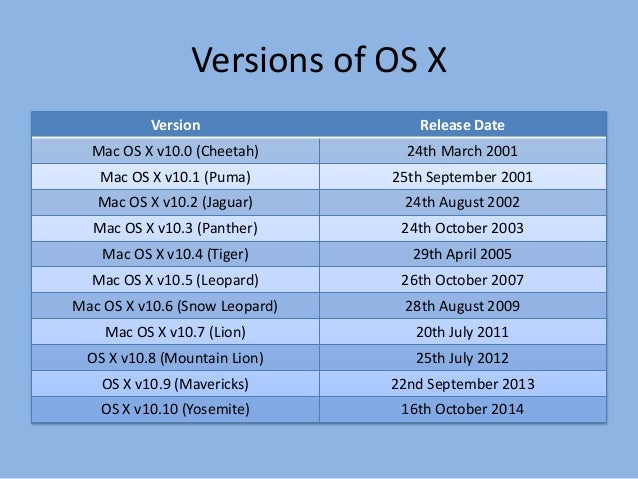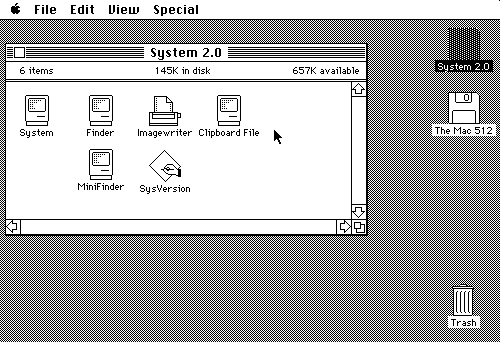Os For Mac History
Is your Mac up to date with the latest version of the Mac operating system (macOS or OS X)? Is it using the version required by some other product that you want to use with your Mac? Which versions are earlier (older) or later (newer, more recent)? To find out, learn which version is installed now.
MacOS, formerly Mac OS X from 2001 to 2012 and OS X until 2016, is the name of an operating system for computers made by Apple Inc. These are called Macintosh computers, or Macs. It differs from other computers, as macOS is supposed to run only on Macs and not on other computers. However, people have made the OS run on computers that are not Macs. Brief history of mac os. UPDATE: In June 2018 is it not confirmed that Mac OS 10.14 Masada will be released only betas of Mac 10.14 will be released then.
If your macOS isn't up to date, you may be able to update to a later version.
Which macOS version is installed?
From the Apple menu in the corner of your screen, choose About This Mac. You should see the macOS name, such as macOS Mojave, followed by its version number. If you need to know the build number as well, click the version number to see it.
This example shows macOS Catalina version 10.15 build 19A583.
Which macOS version is the latest?
These are all Mac operating systems, starting with the most recent. When a major new macOS is released, it gets a new name, such as macOS Catalina. As updates that change the macOS version number become available, this article is updated to show the latest version of that macOS.
If your Mac is using an earlier version of any Mac operating system, you should install the latest Apple software updates, which can include important security updates and updates for the apps that are installed by macOS, such as Safari, Books, Messages, Mail, Music, Calendar, and Photos.
| macOS | Latest version |
|---|---|
| macOS Catalina | 10.15.7 |
| macOS Mojave | 10.14.6 |
| macOS High Sierra | 10.13.6 |
| macOS Sierra | 10.12.6 |
| OS X El Capitan | 10.11.6 |
| OS X Yosemite | 10.10.5 |
| OS X Mavericks | 10.9.5 |
| OS X Mountain Lion | 10.8.5 |
| OS X Lion | 10.7.5 |
| Mac OS X Snow Leopard | 10.6.8 |
| Mac OS X Leopard | 10.5.8 |
| Mac OS X Tiger | 10.4.11 |
| Mac OS X Panther | 10.3.9 |
| Mac OS X Jaguar | 10.2.8 |
| Mac OS X Puma | 10.1.5 |
| Mac OS X Cheetah | 10.0.4 |
Deleting browser history is a good way to make sure your history stays yours. In this article we’ll show you how to safely and quickly remove browser history from your Mac, even from the very first day. It’s not too hard to delete history manually, but there’s a faster way to do it, which is CleanMyMac X. You can download it for free and clean up browsers in just a sec. Moreover, with CleanMyMac, you can remove all the junk from your Mac, including large and old files, broken downloads, system cache, and more. Before you proceed, let's find out what google search history is and why you may want to remove it.
What is search browser history?
When you surf the web, your browser remembers every page you’ve ever visited. Apart from the moments when you choose Incognito Mode (or Private Browsing), all of these pages are carefully stored in your browser and are tied up to your account.
Websites you visit can now show up in autofill Google search forms when you look for them. They will also be highlighted in violet in search results.
Browsers also keep the info about when you have visited these pages. Why browsing history can be useful: you can always resort to it when you need to find that-cool-site-what-was-its-name a month after you visited it.
Why would you want to remove browser history then?
Well, that is absolutely up to you. It could be a matter of privacy, professional etiquette, business confidentiality, paranoia, OCD or taking a general joy in having things cleaned up.
It feels oddly satisfying to know that none of the websites you visited will show up in your Google search results as “already visited”. When you’re giving your Mac to somebody for use or even browsing the web with someone peering over your shoulder, there is a chance they’ll see something they’re not supposed to. Your girlfriend doesn’t know you have been on the wedding ring websites because you lost a bet on how much diamonds cost, she might take it the wrong way.
Os X History
/cdn.vox-cdn.com/uploads/chorus_image/image/55646379/wallpapers_in_finder.0.png)
How to clear browser history?
Apple Operating System Names
Clearing only search history (and there is much more stored info on your Mac) is pretty easy. Simply choose one of the blocks below that deals with the browser you use and follow the steps.
How to delete history in Safari manually:

- Launch Safari.
- Click the History tab, in the top menu.
- Select “Clear History and Website Data…”
- Choose the time range (most likely “all history”) that you wish to clear.
- Click “Clear History.” Done.
How to clear Chrome history manually:
- Open Chrome.
- Click on the burger icon in the top right corner.
- Choose “History.” Hover on it.
- Choose “History” in the popup menu.
- Click “Clear browsing data…”
- Select which time range do you want to clear (probably “the beginning of time…”).
- Checkmark only “Browsing history.”
- Click “Clear browsing data.”
How to clear Firefox history manually:

- Open Firefox browser.
- Open History tab, up in the menu.
- Choose “Clear Recent History.”
- Choose the time range you want cleaned (“Everything” will delete all history).
- See the Details arrow, click on it.
- Choose “Browsing and Download history”.
- Uncheck the rest.
- Hit “Clear now” and you’re good.
How to clear browser history in a click:
Or, you can choose a much faster way of dealing with histories, as well as other extra files on your Mac. Get CleanMyMac X (download for free), go to its Privacy module, choose the browsers you use (or even messengers, if you need to) and clean histories from all of them in a click. Saves you time whenever you need a cleanup.
That’s it for browsing history, but your internet activity is also stored on your Mac in the form of caches, logs, downloads, old files you’ve kept from years ago, and so on. It’s a rule of thumb to give your Mac an occasional cleanup to make sure it works swiftly and stores no junk. You can download CleanMyMac X, a handy cleaning app that takes care of all the junk, so you don’t have to. Keep your Mac and browsers clean, cheers.
These might also interest you:
